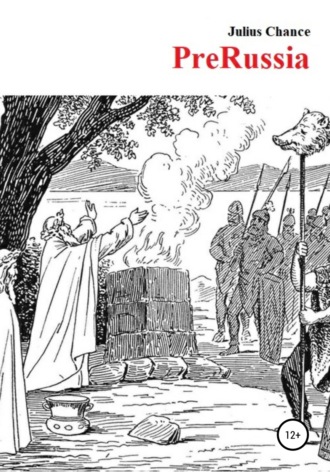
Julius Chance
PreRussia
The birth of Kiev
So, it is unclear exactly where this earliest North Black Sea Russia could be located. Could it initially concentrate around Kiev and develop itself without any Rurik at all? Yet, the name of the city of Kiev in the chronicles is either not mentioned at all or too late to play the role of the capital of original Russia. For the first time the name of the city appears only in the Laurentian Chronicle in the entry for 862 (whereas the Joachim Chronicle says nothing about Kiev at all).
According to the "Tale of Bygone Years" the Apostle Andrew the First-Called predicted the appearance of the city. When the apostle went to preach in Scythia he ascended the Dnieper River to the place of present-day Kiev and said to his disciples: “Do you see these mountains? The grace of God will shine on these mountains, there will be a great city and God will erect many churches.”
Then, climbing further along the Dnieper, he reached the settlements of the Slavs in the area of the Novgorod, where he marveled at the custom of the local population to steam in the baths, painfully whipping themselves with brooms and pouring cold water, which he told later in Rome. Thus, when there were already settlements on the site of Novgorod, only wild grass grew on the hills of Kiev. So he could not have marked the beginning of the emergence of Russia, if we follow this chronicle.
By the legend retold in the "Tale of Bygone Years", Kiev was founded by three brothers: Kiy, Schek, Horiv and their sister Lybid. It was named after Kiy, the elder brother. There are several other versions of the origin of Kiev: Scandinavian, Khazar, Jewish, Armenian, Scythian, etc. One of the versions says that the name of the city came from its first inhabitants who worked on the crossing of the Dnieper. Such workers were called cueans or kiyans. The crossing was a wooden deck on cues (pillars) driven into the bottom. Similar toponyms in other Slavic languages also speak in favor of this version: Kijevo in Croatia and Kujavia in Poland. The settlement founded then by Kiy and his brothers and sister for a long time remained such an insignificant settlement that the chronicler writes about it "gradok" (town).21 The Tale of Bygone Years does not state the date of the foundation of Kiev.
Polish historian M. Stryjkowski (1547-1593) in the third chapter of his 11th book claims that the city of Kiev was founded by Prince Kiy in 430. 22 Yet, archaeological excavations stubbornly indicate that the first small settlements there appeared only in the VI-VII centuries. Some researchers interpret them as "already urban" 23 whereas archaeology shows that the formation of Kiev as a real city occurred at the turn of the IX-X centuries.24 Because of its too late development Kiev is unlikely to play the role of the legendary "Northern Black Sea Rus" which presumably served as a catalyst for the development of Russia in earlier centuries.

The painting "Kiy, Schek, Horiv and Lybid is founding the city of Kiev. 482" by Arthur Orlonov from the website https://commons.wikimedia.org under CC license.
Polyan is the name of a large Slavic tribe (now Polish nation). In the era of spreading, part of the tribe settled along the middle course of the Dnieper on its eastern shore and was known as the Eastern Polyans. Part of the same tribe settled on the west bank, reached the Vistula and Odra and settled in the Gniezno area, thus becoming the Western Polyans and subsequently giving its name to the Poles and Poland. Since the Western Poles were in contact with many other peoples, some Polish historians believe that they originate not so much from the Slavs as from other peoples (there are different opinions from which one). However, scientific studies with the participation of Western experts clearly indicate that Poles are of purely Slavic origin from the point of view of linguistics and anthropology 25 as well as genetics.26
The brothers Lech, Rus and Czech
According to another legend about the founding of the Czech Republic, Poland and Russia, three Slavic brothers hunted together, but one day each decided to go his own way. Rus went east, Czech went west to Mount Rzip near Bohemia and Lech went north where he met a huge white eagle guarding its nest. He founded the settlement of Gniezno and chose a white eagle as his coat of arms. The "Czech Chronicle" of Kozma of Prague (the beginning of the XII century) tells about the arrival in Bohemia of a Slavic tribe led by the "forefather Czech". Lech is present in the Czech version of the legend 27 while Rus is in both the Chech and Polish ones. 28
The "Greater Poland Chronicle" (written approximately in the XIV century) says that "in ancient books they write that Pannonia is the mother and progenitor of all Slavic peoples… Pan the Lord of the Pannonians had three sons of whom the firstborn had the name Lech, the second – Rus and the third – Czech. These three, multiplying in the genus, owned three kingdoms – the Lehites, the Russians and the Czechs also called the Bohemians."
This legend confirms the hypothesis that the Poles are “the people of the lakes”. The word lake in Western Aryan and Celtic sounds like "loch" (recall the famous freshwater lake Ness in Scotland – "Loch Ness"). There are an extraordinary number of lakes in Poland indeed. Perhaps that is why in the Middle Ages they were called lyakhs. The ethnic name "Lechites" is traditionally associated with the name of the mythical ancestor of the Poles – Prince Lech. Among the Tatars, Turks and Russian Cossacks in the XVI-XVII centuries Poland was called Lechistan. In Tajik it is still called “Lakhiston” and in Armenian a polish man is still called “lech”. The word Poles may have originated first as "po lyakhi" (which in Russian means either “to Lechites” or “by Lechites” depending on context) just as the name of the city of Poltava on the river Ltava stands for “po Ltava” meaning “by Ltava” (this is considered to be proven).
The capture of Kiev and Kievan Rus
Rurik's vigilantes Askold and Dir reigned in Kiev in the second half of the IX century. They freed the city of Poles from paying tribute to the Khazar khaganate and boosted its development. In 879, just before his death, Rurik transferred power to Oleg (the regent of Rurik's young son Igor). But after the Rurik’s death Askold and Dir did not obey Oleg. Then, according to the chronicle, in 882 Oleg undertook a military campaign against Kiev. Along the way he conquered Smolensk and Lyubech.
It must be said that Askold and Dir are somewhat mysterious princes. Firstly, it is extremely rare in history for two adequate adults to co-rule any principality. Secondly, both of them were not princely, which was very unusual at that time. Thirdly, as the legend tells, Rurik did not appoint them as the rulers of Kiev direction. They themselves "stumbled upon" it. Fourthly, although they were both killed together at the same time, their graves are located in different places of the city. There is a hypothesis that Askold and Dir were actually a one person with the name Askold (for Askold is spelled Haskuldr in Old Scandinavian). Another assumption is that for the sake of briefness one of the chroniclers (either Nestor or Lavrentyev) simply combined the successive reigns of two different Scandinavian princes at different times into one as there were no important differences between them.
Having approached Kiev, Oleg saw that it would be hard to take such a fortified city standing on a high mountain. Therefore Oleg did not storm the city but pretended to be ostensibly a Varangian (Viking’s) merchant carrying a caravan with goods to Byzantium. He ordered the soldiers to lie down on the bottoms of the ships and throw bags on top of them, imitating the goods. Unaware Askold and Dir with a small squad and merchants went down to the Dnieper to choose goods, leaving the gates of the city open. Oleg's warriors jumped out of their ships and pushed Askold and Dir's men away from their leaders. Then Oleg showed them the son of Rurik and said that they were not of a princely family and therefore could not reign, but he could since he was of a princely family and also a regent. After that by the order of Oleg both Kievan co–rulers were killed and his warriors rushed through the gates. Oleg captured Kiev and declared it to be the capital of united Russia – "the mother of Russian cities." Not all scientists agree that the events unfolded this way.
The era of Kievan Rus began in IX century. Its capital Kiev developed rapidly and by the XI-XII centuries reached its heyday. Kievan Rus gradually expanded its possessions by military force until the outbreak of internecine wars in the XII century. Unfortunately, during the Mongol-Tatar invasion of Russia, Kiev was stormed (on December 5-6, 1240), ruined and fell into decline.
Peter the Great preferred the "Norman Theory"
Note that both the Joachim Chronicle and the "Legend of Slovene and Rus" appeared before the reign of Peter the Great. Later, in the St. Petersburg Academy of Sciences, Peter gave the order to the German and Danish historians to favor the "Norman" version of the origin of the Russian state. They pictured Russia as a state which was formed only by the efforts of Rurik (because the Russian people themselves were allegedly sloppy and incapable of self-organization into a state). And that is why Russia is a little more than a thousand years old and why the Germans have the right to rule Russia (since the Scandinavians – Swedes, Danes, Norwegians, where Rurik supposedly came from, belong to the German group of peoples).
At that time almost all historical primary sources have disappeared somewhere without a trace. Only the censuses remained. This was done of course in order to legitimize the rule of the Romanov family of German origin (actually of Germanized Slavic Prussians as we discussed earlier).
A huge problem for the supporters of the "Norman" theory is the simple fact that the statehood and several large cities appeared in Russia earlier than in Scandinavia. In the IX century the Scandinavian Vikings did not have sufficiently formed states, they were just perfectly able to destroy them in reachable lands. There were only a few small towns in Scandinavia at that time, in fact. It is no accident that the Vikings called Russia "the land of cities." The typical occupation of Viking men then was the robbery of accessible countries, piracy and the sale of the loot. The common sense suggests that if Rurik was a Viking (Varangian) then most likely he came from some other place. For how could he establish the governance of the state in Russia and build cities if he had not had these in his homeland?
In the USSR the role of the alien element in the formation of Ancient Russia was not reflected in mass history textbooks. Under Stalin, those suspected of "Normanism" were in trouble. But in 1763 Lomonosov on the contrary was dismissed from the Academy of Sciences for disagreement with the "Norman" theory. The decree on dismissal was canceled only by the direct intervention of Catherine the Great (Catherine II) for the merits of Lomonosov in other fields of science and his popularity.
Still, Catherine the Great (a German by birth who continued the policy of Peter the Great) also supported the "Norman" theory. During Lomonosov’s life span his works on history were not published at all. After the death of the scientist almost all of his works disappeared without a trace with the exception of only a few "edited" by German professors from the Russian Imperial Academy of Sciences (mainly by Professor of history Gerhard Friedrich Miller, russified name Fyodor Ivanovich Miller). And even they were printed only years after Lomonosov's death.
One of the acts of the "Normans" was the dubious interpretation by the Russian historian N.M. Karamzin of the key word from the Lavrentyev census "The Tale of Bygone Years" (until the age of 30 the historian lived and worked during the reign of Catherine II). The phrase “Our land is great and plentiful, but there is no naryad in it, come to reign and ‘volodet’ us” was interpreted by him as “Our land is great and plentiful, but there is no order in it, come to reign and own us.”
Linguists of the Old Slavic language relying on a large number of examples from historical sources defines "naryad" as "order, arrangement, law and order, organization", "activities for the arrangement, organization of something, management, supervision", "order to send to work, to service, assignment, order", etc . There are the expressions "naryad for firewood", "naryad for an apartment", etc. in Russian language. This means an order for the issuance of firewood, the provision of an apartment, etc.29 "To go to ‘naryad’" means to go on guard duty by order. Thus this phrase should be understood as the fact that we do not have a ruler.
It is no accident that in several other chronicles (for instance in the Novgorod Fourth Chronicle 30) this phrase reads like "our land is good and great, it is abundant in everything, but there is no ‘naryadnik’ in it." The word "naryadnik" directly means "manager, boss, leader" according to the "Dictionary of the Russian language of the XI—XVII centuries".






